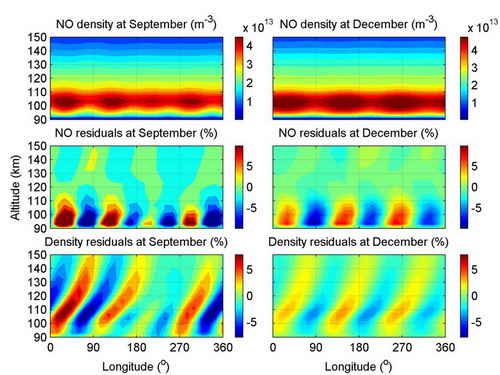Postdoctor REN Zhipeng and his teacher WAN Weixing report the longitudinal variations in the lower thermosphere nitric oxide (NO) on the basis of the GCITEM‐IGGCAS model and tides from TIMED/SABER observations.
They simulate the intra-annual variation of the NO density and find that equinoctial lower thermospheric NO density shows an obvious wave number 4 longitudinal structure both in equinox and in June solstice and a wave number 3 longitudinal structure in December solstice.
They simulations also show that the NO density residuals and the neutral mass density residuals in the height range between 90 and 120 km agree well with each other, and the neutral mass density mainly affects the longitudinal variations of lower thermospheric NO density through modulation of the chemical production rate, e.g., through affecting the chemical reaction between excited nitrogen and molecular oxygen.
Ren et al. Simulated longitudinal variations in the lower thermospheric nitric oxide induced by nonmigrating tides. Journal of Geophysical Research, 2011, 116(A4),A04301, doi:10.1029/2010JA016131(Download Here)

Figure 1. Longitudinal and altitudinal variations of (top) the simulated NO densities, (middle) the NO density residuals, and (bottom) the neutral mass density residuals at equator for (left) September and (right) December. (Image by REN Zhipeng)